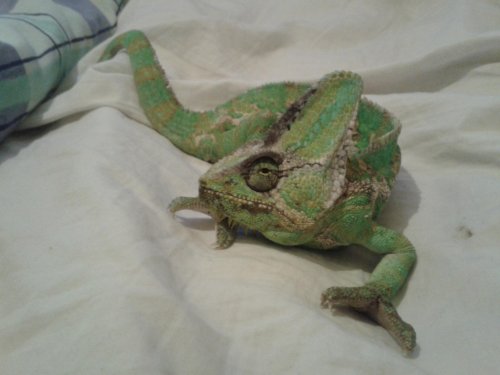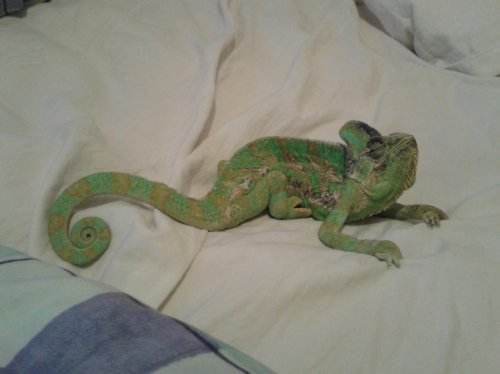Chameleon88
New Member
Hey guys pretty new on here, I currently own a veiled chameleon that I have had for just over a year now which I bought from a breeder.
I have an Arboreal vivarium.
He's on two 24 hour timers 1 UV bulb & 60w Heat bulb with a glow lamp, with a day temp of 90 dropping down to 75/70 at night.
I mist his viv 3 times a day with water.
His diet consists of crickets, locusts and occasionally meal worms to vary it a bit which I gut load and feed around a dozen every other day.
He has plenty of coverage for him to hide and vines to climb.
Over the past week he has shown signs of severe MBD, At the time of discovering this I had no idea at what was happening, after researching his symptoms I narrowed it down to this. He was trembling when attempting to climb, unable to use his tongue, lack of colour changing, thin bones, slightly curved crest, lack of appetite since visiting the vets was recommended to feed him liquid calcium.
Upon realizing this I revisited the store I bought my equipment and arranged to speak to there "EXPERT" upon telling him his symptoms he recommended i googled it!!! so i researched thesyptoms and found the cause of this disease. When I set up his viv I sought advice from a well known uk pet store and was advised that a 2 UV bulb was sufficient for my chameleon. Upon researching this I have found that a minimum of 10 UV bulb should have be used. I was also told If this bulb was used it would not require me to dust his food with calcium, Although I thought this odd and still dusted once or twice a month.
During the time of rearing him I thought nothing of his behaviour due to him being lethargic, thinking him to be of a docile nature not because of his lack of calcium.
Since finding this out I have replaced his 2 uv bulb with also an additional 10 uv bulb, I also purchased a smoothie maker and have been blending his food and been feeding him in intervals though out the day with his diet blended through a syringe.
I was also instructed to supply him with liquid calcium daily at his required amount for his body weight in grams to help speed up his recovery.
he has shown signs of improvement such as moving around his cage, responding to me, he is no longer sleeping with his eyes closed during the day. Although he is still refusing to eat solids, and is eating through the syringe at the moment.
Does anyone else have any advice to help with his recovery, I am extremely upset with advice given seeing as it is a well know chain branch and amazed they are aloud to advice people with such a lack of knowledge..
please help with any advice as it would be greatly appreciated.
kind regards
Rob
I have an Arboreal vivarium.
He's on two 24 hour timers 1 UV bulb & 60w Heat bulb with a glow lamp, with a day temp of 90 dropping down to 75/70 at night.
I mist his viv 3 times a day with water.
His diet consists of crickets, locusts and occasionally meal worms to vary it a bit which I gut load and feed around a dozen every other day.
He has plenty of coverage for him to hide and vines to climb.
Over the past week he has shown signs of severe MBD, At the time of discovering this I had no idea at what was happening, after researching his symptoms I narrowed it down to this. He was trembling when attempting to climb, unable to use his tongue, lack of colour changing, thin bones, slightly curved crest, lack of appetite since visiting the vets was recommended to feed him liquid calcium.
Upon realizing this I revisited the store I bought my equipment and arranged to speak to there "EXPERT" upon telling him his symptoms he recommended i googled it!!! so i researched thesyptoms and found the cause of this disease. When I set up his viv I sought advice from a well known uk pet store and was advised that a 2 UV bulb was sufficient for my chameleon. Upon researching this I have found that a minimum of 10 UV bulb should have be used. I was also told If this bulb was used it would not require me to dust his food with calcium, Although I thought this odd and still dusted once or twice a month.
During the time of rearing him I thought nothing of his behaviour due to him being lethargic, thinking him to be of a docile nature not because of his lack of calcium.
Since finding this out I have replaced his 2 uv bulb with also an additional 10 uv bulb, I also purchased a smoothie maker and have been blending his food and been feeding him in intervals though out the day with his diet blended through a syringe.
I was also instructed to supply him with liquid calcium daily at his required amount for his body weight in grams to help speed up his recovery.
he has shown signs of improvement such as moving around his cage, responding to me, he is no longer sleeping with his eyes closed during the day. Although he is still refusing to eat solids, and is eating through the syringe at the moment.
Does anyone else have any advice to help with his recovery, I am extremely upset with advice given seeing as it is a well know chain branch and amazed they are aloud to advice people with such a lack of knowledge..
please help with any advice as it would be greatly appreciated.
kind regards
Rob



